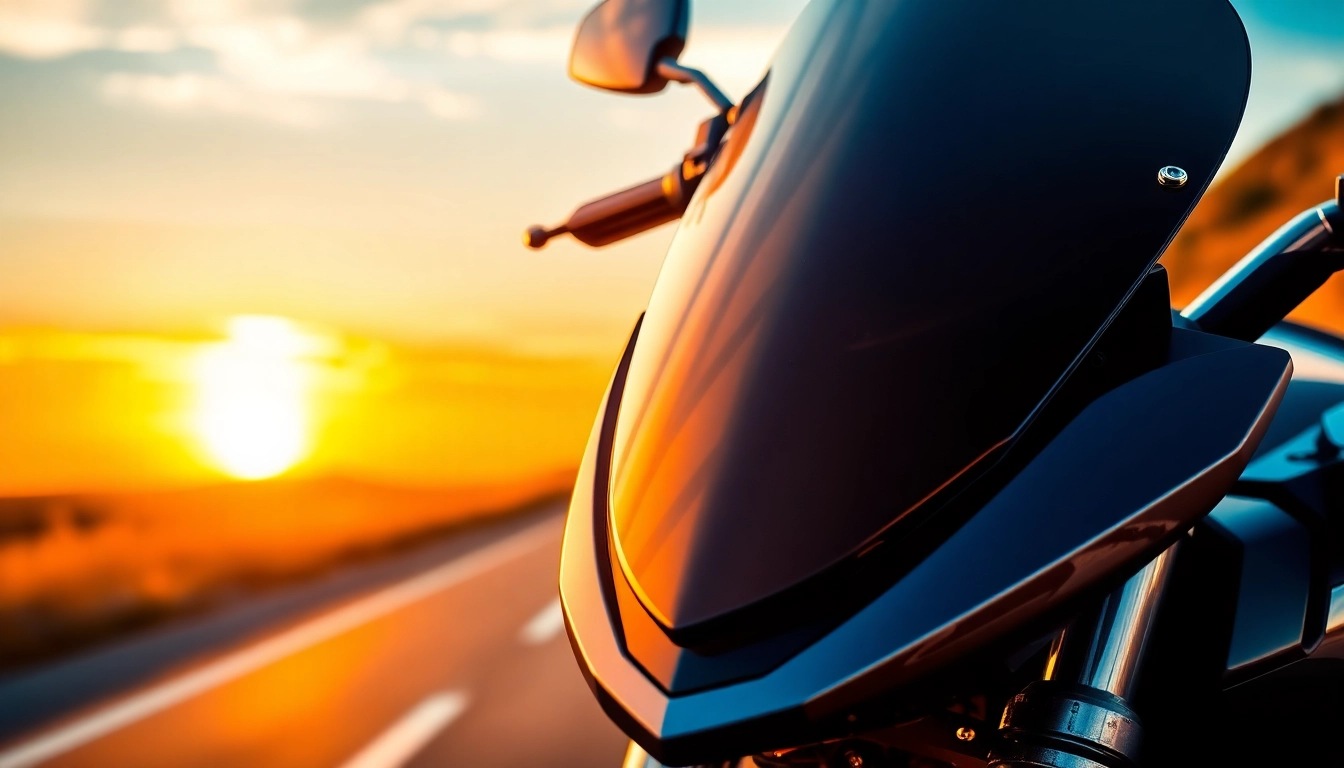Understanding Motorcycle Windscreens
What Are Motorcycle Windscreens?
Motorcycle windscreens are transparent panels mounted to the front of a motorcycle, typically above the handlebars. These panels serve the primary purpose of deflecting wind, rain, bugs, and other debris that a rider might encounter while operating their motorcycle. By creating a barrier between the rider and the elements, motorcycle windscreens enhance ride stability and improve overall comfort. In essence, they are an essential component in the motorcycle ecosystem, as they not only protect the rider but also contribute to the bike’s aerodynamics and aesthetics.
Importance of Motorcycle Windscreens
The significance of motorcycle windscreens cannot be overstated. They play a multifaceted role that extends beyond mere protection against the elements. One of the critical functions of a windscreen is to improve aerodynamics. For motorcyclists, especially those traveling at high speeds, the worst enemy is wind resistance. A well-designed windscreen minimizes drag, allowing bikes to cut through the air more efficiently. Moreover, they protect the rider from wind fatigue, enhancing comfort during long rides. Ultimately, the right windscreen can mean the difference between an enjoyable two-wheeled excursion and a headache-inducing experience.
Types of Motorcycle Windscreens
Motorcycle windscreens come in various shapes and sizes, each designed with specific riding styles and preferences in mind. Some common types include:
- Touring Windscreens: These are often larger and provide extensive coverage to enhance comfort on long-distance rides.
- Sport Windscreens: Designed with sleek, aerodynamic shapes, these are typically shorter and cater to a sporty riding position.
- Universal Windscreens: Versatile options that can fit a range of motorcycle models, making them a popular choice for aftermarket installations.
- Custom Windscreens: Tailored windshields made to fit specific motorcycle models or unique rider preferences.
Benefits of Motorcycle Windscreens
Improved Aerodynamics
A well-designed windscreen significantly enhances the aerodynamics of a motorcycle. By reducing wind resistance and drag, the motorcyclist experiences less fatigue. The overall riding experience becomes more fluid and enjoyable. Studies have shown that the right windscreen can lower the coefficient of drag, allowing for improved fuel efficiency, faster speeds, and a more controlled ride. Riders engaging in long-distance travel can achieve considerable benefits from aerodynamic efficiency, reducing the physical strain on their bodies.
Enhanced Rider Comfort
Rider comfort is paramount on any motorcycle journey. A motorcycle windscreen helps reduce the amount of direct wind hitting the rider, greatly decreasing wind fatigue and enhancing comfort. On cooler days, the windscreen can also help retain warmth, making rides more pleasant. Riders can travel longer distances without succumbing to discomfort caused by exposure to the elements. In essence, windscreens act as personal shields that allow riders to focus on the road ahead instead of the challenges posed by the weather.
Stylish Aesthetics
Beyond functionality, motorcycle windscreens add a touch of style to the overall look of a motorcycle. Available in various designs, colors, and materials, windscreens can complement a bike’s overall aesthetic and reflect the rider’s personal style. From chrome accents to tinted glass, the right windscreen enhances visual appeal while delivering performance benefits. Custom designs also allow for creative expression, further solidifying the windscreens’ role as both a practical and stylistic choice for riders.
Choosing the Right Motorcycle Windscreen
Factors to Consider
When selecting a motorcycle windscreen, several key factors come into play: the type of riding, speed preferences, the style of the motorcycle, and personal comfort. Here are some of the major considerations:
- Riding Style: Determine whether you’ll be using the motorcycle for touring, commuting, or sports riding, as each requires a different windscreen design.
- Height and Position: Consider your height and riding position; taller riders may benefit from taller screens, while shorter riders might prefer more streamlined options.
- Material: Windscreens are commonly made from materials such as polycarbonate and acrylic. Durability, weight, and clarity should all be taken into account when selecting the material.
Popular Brands and Models
Several popular manufacturers dominate the motorcycle windscreen market, each offering high-quality products. Brands like motorcycle windscreens manufacturers Memphis Shades and National Cycle are renowned for their extensive range of options. Memphis Shades produces durable windscreens that can withstand the test of time, while National Cycle focuses on advanced scratch-resistant technology. Other notable brands include Zero Gravity, Givi, and Puig, each known for their unique innovations and customization options.
Custom vs. Universal Windscreens
Riders must decide between opting for a custom windscreen or a universal model. Custom windscreens are tailored to fit specific motorcycle models, ensuring optimal performance and aesthetic integration. However, they can be more expensive and may require longer lead times. On the other hand, universal windscreens offer versatility and can potentially accommodate multiple models; however, the fit might not be as seamless. It is crucial to weigh these options based on riding needs and budgetary constraints.
Installation and Maintenance of Motorcycle Windscreens
Step-by-Step Installation Guide
Installing a motorcycle windscreen can be a straightforward process if you follow a systematic approach. Here’s a step-by-step installation guide:
- Gather Your Tools: You will need a screwdriver, wrench, and possibly a drill depending on the windscreen model.
- Remove Existing Windshield: If replacing, carefully unscrew the current windscreen, taking note of any mounting brackets.
- Position the New Windscreen: Align the new windscreen with the mounting points on your motorcycle.
- Secure the Windscreen: Use the appropriate screws and brackets to attach it securely, ensuring there are no obstructions.
- Test Stability: Gently shake the windscreen to confirm it’s firmly installed. If needed, make adjustments.
Maintenance Tips for Longevity
Proper maintenance is crucial for the longevity and effectiveness of motorcycle windscreens. Here are some essential tips:
- Regular Cleaning: Use a gentle, non-abrasive cleaner specifically designed for motorcycle windshields to maintain clarity and prevent scratches.
- Avoid Harsh Chemicals: Chemicals such as ammonia can damage the windscreen material. Always check product labels before application.
- Inspect for Damage: Routinely check for cracks, chips, or loose fittings, and address any issues immediately to avoid further damage.
Common Issues and Solutions
While motorcycle windscreens are generally robust, they can present a few common issues. Here are some solutions:
- Visibility Issues: If there is cloudiness or scratches, consider using specialized polish to restore clarity.
- Loose Fittings: If the windscreen feels wobbly, tighten the screws and inspect mounting brackets for any signs of wear or breakage.
- Noise from Wind: If excessive noise occurs while riding, consider adjusting the windscreen angle or opting for a different design better suited for your riding style.
Future Trends in Motorcycle Windscreens
Innovations in Materials and Design
As technology advances, the materials used in motorcycle windscreens are becoming more sophisticated. Innovations like lightweight composites and advanced polymers are gaining popularity due to their strength and flexibility. Furthermore, aerodynamic designs are being continuously optimized. Windscreens of the future may even integrate adjustable features, allowing riders to modify their height or angle on-the-fly, offering personalized comfort and performance on demand.
Eco-Friendly Solutions
With an increasing emphasis on sustainability, manufacturers are exploring eco-friendly materials for windscreens. The industry is looking into recyclable and bio-based materials that decrease the environmental footprint. Sustainability not only benefits the environment but attracts a growing demographic of eco-conscious riders seeking alternatives that align with their values.
Market Trends and Predictions
The market for motorcycle windscreens is poised for growth driven by the rising number of motorcycle enthusiasts globally. As safety standards evolve and the demand for comfortable riding experiences increases, the windscreen market will need to adapt by integrating advanced features. Expect to see an influx of smart technology in future iterations, such as built-in sensors to detect speed and adjust windscreen performance dynamically. The future of motorcycle windscreens will not only prioritize comfort and style but also embrace innovation and ecological responsibility.


